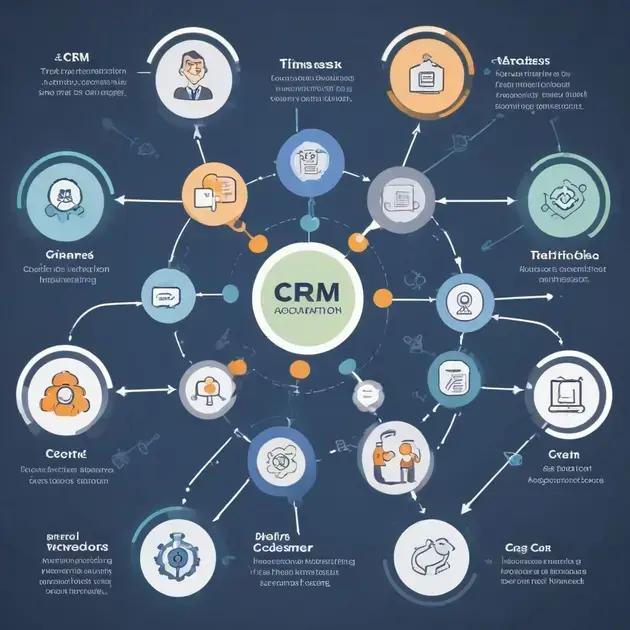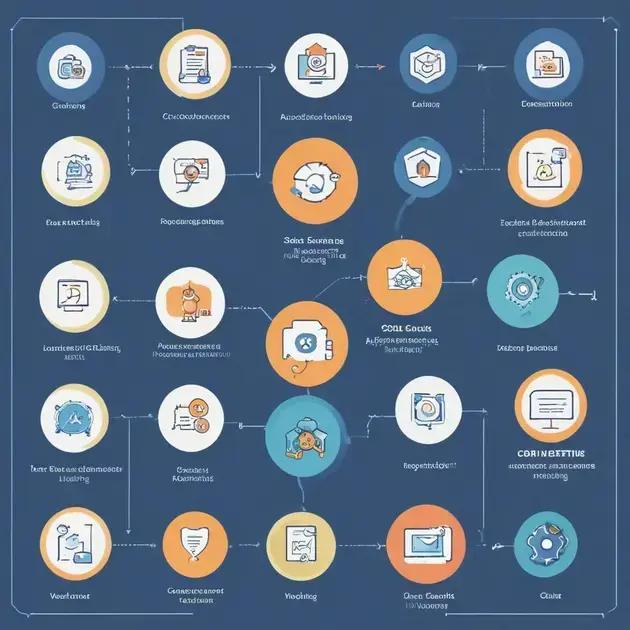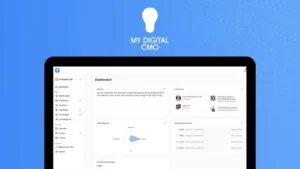Integrating CRM and sales automation tools effectively streamlines operations, enhances customer relationships, and drives sales growth. By measuring key metrics and continuously refining strategies, businesses can fully leverage these systems for optimal success.
CRM and sales automation are crucial tools in today’s fast-paced business world. They enable companies to streamline their operations and improve customer interactions. In this post, we’ll delve into the essentials of CRM, explore how sales automation complements these systems, and what businesses stand to gain from their effective integration.
Understanding CRM and Sales Automation
Understanding CRM and Sales Automation is essential for any business looking to improve its customer relationships and streamline processes. Customer Relationship Management (CRM) systems are designed to help businesses manage and analyze customer interactions throughout the customer lifecycle. By doing so, they improve customer service relationships and assist in customer retention.
Sales automation, on the other hand, focuses on automating repetitive tasks in the sales process. This includes managing leads, tracking communications, and following up on opportunities. By integrating CRM with sales automation, businesses can create a seamless experience for both the sales team and the customer.
How CRM Enhances Sales Automation
CRM systems store vital information about prospects and customers. This information enables sales teams to approach their tasks with insights into past interactions and preferences, leading to more personalized approaches. Integration with sales automation tools can track important interactions automatically and provide reminders for follow-ups, ensuring no opportunity is missed.
Benefits of Understanding CRM and Sales Automation
One significant benefit is improved efficiency. Sales automation reduces the time spent on administrative tasks, allowing sales representatives to focus on selling. Additionally, better data management through CRM provides analytics that help in forecasting and strategy development.
Why Businesses Need to Invest
Investing in CRM and sales automation is no longer optional but a necessity in a competitive landscape. By understanding these tools, businesses can enhance their sales processes, improve customer satisfaction, and ultimately drive higher revenues.
For businesses of all sizes, the integration of CRM and sales automation creates opportunities to adapt to changing market demands and customer preferences. This understanding is the first step toward unlocking the full potential of these crucial systems.
Benefits of Integrating CRM with Sales Automation

Benefits of Integrating CRM with Sales Automation are significant for businesses aiming to enhance their sales processes and customer interactions. The integration of these two powerful systems creates a streamlined approach that can lead to notable increases in efficiency and productivity.
One major benefit is the automation of routine tasks. By automating tasks such as data entry, lead tracking, and follow-up reminders, sales teams can allocate their time to more crucial activities like closing deals and building relationships.
Improved Data Management
When CRM systems integrate with sales automation tools, data flows smoothly between them. This consolidation means sales teams have access to up-to-date information about leads and customers, which leads to more personalized and effective communication.
Enhanced Customer Insights
Integrating these systems provides businesses with deeper insights into customer behavior and preferences. With access to analytics, teams can tailor their marketing efforts to target specific customer needs, leading to higher conversion rates.
Streamlined Sales Processes
The integration allows for a more coherent sales process where all steps—from prospecting to closing—are connected. This reduces the chances of leads falling through the cracks and ensures that all interactions are logged and monitored, providing full visibility into the sales pipeline.
Better Collaboration Among Teams
Sales teams can work more effectively with marketing and customer service teams. The data shared between CRM and sales automation systems fosters collaboration, making it easier to align efforts and strategies across departments.
The ultimate goal of integrating CRM with sales automation is to drive revenue growth through a better understanding of customers and more efficient sales practices. The combination of these tools creates a competitive advantage that every business should consider.
Choosing the Right CRM and Sales Automation Tools
Choosing the Right CRM and Sales Automation Tools is crucial for any organization aiming to enhance their sales process. With numerous options available on the market, it can be challenging to determine which tools will best meet your business’s specific needs.
Begin by assessing your company’s unique requirements. Consider the size of your team, the nature of your business, and the specific challenges you face in sales and customer management. This understanding helps to narrow down which features and functionalities are essential.
Key Features to Consider
When selecting CRM and sales automation tools, look for capabilities such as lead management, contact management, and sales forecasting. A good CRM should provide an intuitive dashboard that allows easy access to customer data and sales metrics.
Integration Capabilities
It’s also important to choose tools that work well together. Look for CRM systems that can integrate seamlessly with your existing sales automation software and other business applications. This ensures a smooth flow of data and reduces the likelihood of inconsistencies.
User Experience and Support
The usability of a CRM tool is another crucial factor. Choose a platform that is easy to use and offers good customer support. Training and support resources can make a big difference in how quickly your team can adopt the new system.
Cost and Scalability
Cost is always a consideration. Evaluate the pricing models of different tools, especially if you plan to scale your operations in the future. Some tools may offer pay-as-you-go options or tiered pricing that scales with your business growth.
By selecting the right CRM and sales automation tools, you can equip your sales team with the necessary resources to thrive. This investment can lead to improved customer relationships, focused sales efforts, and ultimately, increased revenue.
How to Implement CRM and Sales Automation

How to Implement CRM and Sales Automation effectively requires careful planning and a clear understanding of your business processes. Successful implementation can help streamline operations and improve customer interactions.
Start by defining your goals. What do you want to achieve with your CRM and sales automation? Is it to improve customer communication, track sales more accurately, or automate repetitive tasks? Clearly identifying your objectives will guide the implementation process.
Assess Your Current Processes
Before integrating new tools, it is essential to assess your current processes. Identify what works well and what needs improvement. Mapping out your existing sales workflow will help you understand how CRM and sales automation can fit into your operations.
Choose the Right Tools
Select CRM and sales automation tools that align with your business needs. Look for features that support your objectives, such as email tracking, lead management, and reporting. Ensure that the tools you consider can integrate smoothly with one another.
Train Your Team
Training is crucial for successful implementation. Provide comprehensive training for your team on how to use the new systems. This increases user adoption and minimizes resistance to change. Schedule regular training sessions and provide resources that help them understand how to maximize the tools’ potential.
Start Small
Implement the changes gradually instead of trying to do everything at once. Begin with a pilot project that tests a few specific features or processes. Monitoring the impact of this pilot will help you make informed adjustments before a full rollout.
Monitor and Optimize
After implementation, continuously monitor the system’s performance. Gather feedback from users to identify any areas that need further improvement. Use analytics to measure success based on the goals you set initially. Being open to adjustments will help you refine the system for better results.
Measuring Success with CRM and Sales Automation
Measuring Success with CRM and Sales Automation is vital to understanding the effectiveness of your implementations. By tracking specific metrics, businesses can determine how well these tools are contributing to their goals.
First, define clear objectives for what success looks like. This may include increased sales, improved customer satisfaction, or higher lead conversion rates. Having specific targets allows you to measure your results against them.
Key Performance Indicators (KPIs)
Utilize key performance indicators (KPIs) to track progress. Common KPIs for CRM and sales automation include:
- Lead Conversion Rate: The percentage of leads converted into paying customers.
- Sales Cycle Length: The average time it takes to close a sale.
- Customer Retention Rate: The percentage of customers who continue to do business with you over a specific period.
- Customer Lifetime Value (CLV): The total revenue you can expect from a customer throughout their relationship with your business.
Utilizing Reporting Tools
Most CRM systems come with built-in reporting tools that allow you to visualize data and track these metrics over time. Use these tools to generate regular reports that can help you identify patterns and areas for improvement.
Gathering Feedback
In addition to quantitative data, gathering feedback from your sales team and customers provides valuable insights. Understanding their experiences with the CRM and sales automation tools can highlight strengths and weaknesses.
Adjusting Strategies Based on Data
Finally, be prepared to adjust your strategies based on the data you collect. Implementing CRM and sales automation is not a one-time process but an ongoing effort. Regularly reviewing your metrics and feedback will help you refine your approach and optimize performance.
In Summary: Unlocking the Power of CRM and Sales Automation
Integrating CRM and sales automation tools can be a game changer for any business. These systems work together to improve efficiency, enhance customer relationships, and drive sales growth.
By understanding how to implement these tools effectively, assess their impact, and continuously refine your strategies, you can ensure that your business reaps the full benefits. Monitoring key metrics and gathering feedback will guide your efforts, making sure you stay ahead in a competitive landscape.
Embracing CRM and sales automation is not just about keeping up with technology; it’s about unlocking new opportunities for success and innovation in your business.
FAQ – Frequently Asked Questions about CRM and Sales Automation
What is a CRM system and how does it help businesses?
A CRM system helps businesses manage interactions with customers and store vital information, leading to improved customer relationships and sales.
How can sales automation benefit my sales team?
Sales automation streamlines repetitive tasks, allowing your sales team to focus more on selling and building relationships with customers.
What key features should I look for in CRM and sales automation tools?
Look for features like lead management, analytics, reporting, and easy integration with existing systems.
How do I measure the success of my CRM and sales automation implementation?
Success can be measured using KPIs such as lead conversion rates, sales cycle length, and customer retention rates.
Why is training important for using CRM and sales automation tools?
Training helps your team effectively use the tools, leading to higher adoption rates and ultimately improving sales processes.
What can I do to continuously improve my CRM and sales automation strategies?
Regularly monitor performance metrics, gather feedback from users, and be open to making adjustments based on the data collected.




